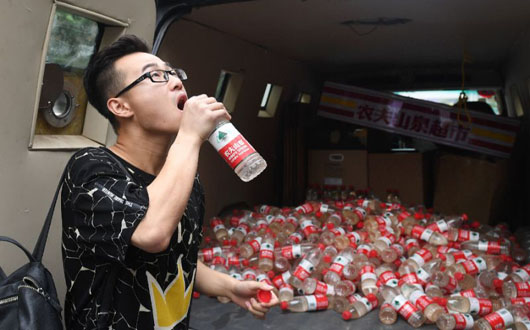BEIJING, July 14, 2018 (BSS/AFP) – At first glance, it may seem like just a
black truck filled with bottles of water, but a closer look reveals a darker
— or rather murkier — side to what’s sloshing around inside.
Its cargo of more than 500 bottles of Nongfu Spring, a ubiquitous Chinese
brand, filled with contaminated drinking water from the village of Xiaohaotu
in China’s northwest Shaanxi province is being driven around Beijing as a
reminder of the costs of the country’s rapid economic development.
The mobile exhibition, created by “Nut Brother” — an artist known for
advocacy work on environmental and social issues — was created in defiance
after his initial show was shut down.
Shocked by Shaanxi’s dirty drinking water during a work trip to the
province in May, the 37-year-old enlisted the help of villagers to fill 9,000
empty Nongfu bottles and brought them back to Beijing, where they were
installed in a museum.
The exhibition caught the attention of Nongfu Spring Company and two weeks
later, authorities from the Industrial and Commercial Bureau dismantled his
display, removing most of the bottled water.
The company later filed a complaint claiming his work infringed on its
copyright.
“Nongfu Spring literally means ‘farmer’s spring water’, using village
farmers as a brand,” Nut Brother — who does not reveal his name to the media
— told AFP.
“But the reality is farmers don’t drink this water. A lot of their water
is seriously tainted with pollution.”
Nongfu Spring Company’s legal department refused interview requests and
calls to their public relations team went unanswered.
Large parts of China are blanketed in toxic smog and suffer from polluted
waterways as a result of the country’s economic boom.
While much attention has been paid to the impact of rapid
industrialisation on China’s air, the effects on the country’s water supply
are less well known — and less visible.
Across China, much of the water is “unfit for human contact”, according to
a 2017 report by Greenpeace East Asia, and 14 of 31 provinces failed to meet
water quality targets despite a nationwide push for improvement in previous
years.
“They’ve been drinking this water for more than 10 years,” Nut Brother
said.
The samples contain high levels of iron and manganese, which can be toxic
in large doses, he added.
“It’s not fit for consumption but the villagers have no choice.”
The roving exhibit seems to have startled some visitors.
“It’s shocking to know we have people who drink this kind of water,” one
of the onlookers said.
Another passerby bravely took a swig from the bottle. “You can definitely
feel bits of the dirt,” he said.
“It makes me feel very lucky to be able to drink clean water. Very lucky.”



